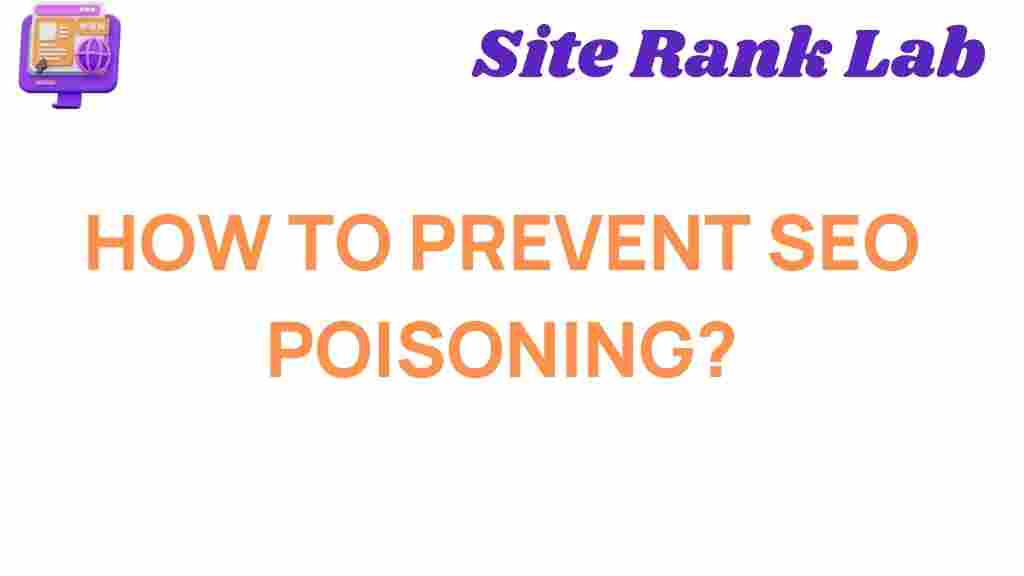Unmasking SEO Poisoning: Essential Tactics for Protection
In the rapidly evolving world of digital marketing, the term SEO poisoning has emerged as a critical concern for businesses striving to maintain their online presence. As cyber threats increase, understanding how to protect your website from these attacks is crucial. This article will delve into what SEO poisoning involves, its implications for website security, and provide essential tactics to safeguard your online reputation.
What is SEO Poisoning?
SEO poisoning refers to the malicious practice of manipulating search engine results to direct users to harmful websites, often laden with malware or phishing schemes. Cybercriminals capitalize on popular search queries by creating content that appears legitimate but ultimately leads to unsafe sites. This tactic not only endangers users but can severely damage a brand’s online reputation and web traffic.
Understanding the Risks of SEO Poisoning
Businesses must comprehend the risks associated with SEO poisoning to formulate effective defenses. The implications include:
- Malware Attacks: Users who unknowingly click on poisoned links may download harmful software, compromising both their devices and personal data.
- Phishing: SEO poisoning can lead to deceptive sites that mimic legitimate businesses, tricking users into providing sensitive information.
- Online Reputation Damage: If users associate your brand with unsafe search results, it can lead to a loss of trust and customers.
- Decreased Web Traffic: Malicious links can lead to a drop in legitimate visitors as your site becomes associated with unsafe content.
Essential Tactics for Protection Against SEO Poisoning
To protect your business from the dangers of SEO poisoning, consider implementing the following tactics:
1. Regularly Monitor Your Website
Consistent monitoring of your website is vital. Use tools like Google Search Console to track your website’s performance and identify any suspicious activity. Regularly check:
- Your search traffic for sudden drops or unusual spikes.
- The integrity of your website’s content for unauthorized changes.
- Backlinks to ensure they are from reputable sources.
2. Implement Robust Website Security Measures
Enhance your website security by adopting the following measures:
- Use HTTPS: Ensure your site is secured with HTTPS, which encrypts data between the user and your site.
- Regular Software Updates: Keep all software, plugins, and themes updated to patch vulnerabilities.
- Web Application Firewalls: Employ firewalls to filter and monitor traffic, blocking harmful requests.
3. Educate Your Team on Cybersecurity
Your employees are often the first line of defense against cyber threats. Conduct regular training sessions to educate them about cybersecurity best practices, including:
- Recognizing phishing attempts.
- Creating strong passwords and using two-factor authentication.
- Handling sensitive data responsibly.
4. Optimize Your SEO Practices
To mitigate the risks of SEO poisoning, ensure your SEO practices are ethical and effective. Focus on:
- High-Quality Content: Create valuable, relevant content that meets user intent. Avoid clickbait titles that may mislead users.
- Reputable Backlinks: Build relationships with trustworthy sites to enhance your backlink profile.
- Regular SEO Audits: Conduct audits to identify any weak spots in your SEO strategy.
5. Utilize Security Tools
Employ various security tools to protect your website:
- Antivirus Software: Use reliable antivirus solutions to detect and remove malware.
- Website Scanners: Tools like Sucuri or SiteLock can help scan your site for vulnerabilities.
- Monitoring Services: Services that alert you to changes in your website can help you react quickly to potential threats.
Troubleshooting SEO Poisoning Issues
If you suspect that your website has been affected by SEO poisoning, follow these troubleshooting steps:
1. Identify the Source of the Problem
Use tools like Google Search Console to identify any unusual search queries leading to your site. Check for:
- Unrecognized keywords.
- Suspicious backlinks or referring domains.
2. Remove Harmful Content
If you find any content that is harmful or misleading, remove it immediately. This includes:
- Malware-infected files.
- Links to phishing websites.
3. Disavow Bad Backlinks
Use Google’s Disavow Tool to inform search engines that you do not want certain backlinks affecting your website’s ranking. This is crucial for maintaining your site’s integrity.
4. Request a Review
Once you’ve cleaned up your website, you can request a review from search engines to remove any penalties incurred due to SEO poisoning. Follow the guidelines provided by Google or other search engines to ensure a smooth process.
5. Strengthen Your Security Posture
After addressing any issues, revisit your security measures to ensure they are robust enough to prevent future incidents. Consider implementing additional layers of security like:
- Intrusion detection systems.
- Regular security audits by experts.
Conclusion
In the realm of digital marketing, SEO poisoning poses a significant threat to businesses and their online reputations. By understanding the risks and implementing essential protective measures, you can safeguard your website from malicious attacks. Remember, maintaining a strong security posture is an ongoing process that requires vigilance and adaptation to emerging threats.
For more information on website security and cybersecurity best practices, consider visiting this resource that provides in-depth insights into protecting your online presence. Additionally, you can explore further tactics on improving your digital marketing strategy to ensure your business thrives safely in the digital landscape.
This article is in the category SEO and created by SiteRankLab Team
